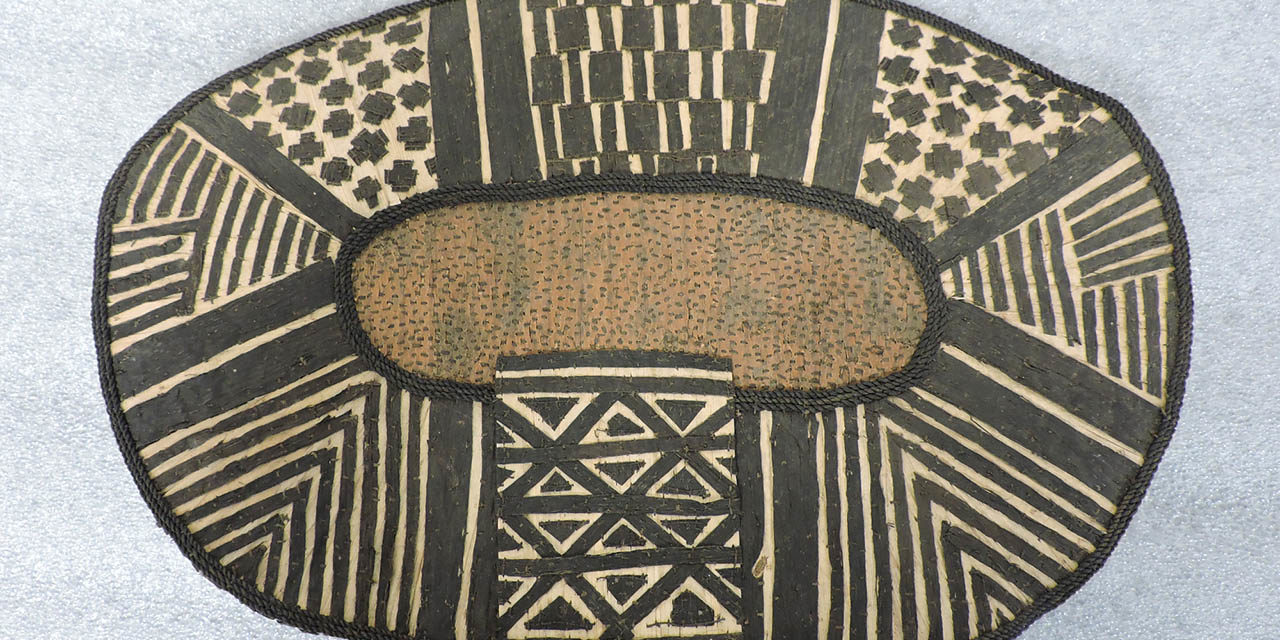An oval-shaped decorative pad worn by Mangbetu women over the buttocks in Central Africa.
The Details
Enid Schildkrout and Curtis A. Keim describe Mangbetu dress, covering the back apron (negbe), in the Berg Encyclopedia of World Dress and Fashion: Africa (2010):
“Women wore a rectangular bark-cloth garment, the nogetwe, as a short skirt or sometimes an apron. In the past, and still today for ceremonial displays, it was left open in the rear to reveal the negbe, or back apron, an oval fiber pad fastened around the waist with a string.” (382)
The Smithsonian has a back apron (Fig. 1) woven from dyed and undyed plant fibers. An oval of undyed fiber is in the center, with geometric, triangular, and crossed patterned sections of fibers circling the center area.
Anne Leurquin details the back apron in A World of Belts: Africa, Asia, Oceania, America: from the Ghysels Collection (2004):
“The latter used to wear a cache-sexe made of banana leaves, flattened, dried and sewn together, and decorated with a cylinder in front, while a negbe, or buttock apron, of the same material, decorated with a geometric pattern, was attached to the belt in the back.” (13)
As seen in figure 2, the Metropolitan Museum of Art has a kidney-shaped apron made from dried, layered banana leaves. The apron mimiced the shape of the Mangbetu halo haircut, a conical-shaped hairdo at the back of the head.
Enid Schildkrout writes in Les Parisiens d’Afrique: Mangbetu Women as Works of Art (2008):
“Women carried and also wore small pieces of barkcloth in front of the pubic area. In back, they wore a palm fiber apron called a negbe, decorated by overlaid and appliqued patterns of light and dark fiber.” (9)
The Brooklyn Museum has an oval-shaped apron (Fig. 3) composed of banana leaf material. The center is plain with dark brown stitching, and a border of dark brown bands circles the center. A roll of fiber is attached to the top, decorated with a geometric pattern.
Another example of the back apron is seen in figure 4, sourced from Andres Moraga Textile Art. It has a plain center detailed with dark brown stitching, and a geometric pattern with dark brown bands lining the central oval.
Fig. 1 - Artist unknown (Mangbetu culture). Apron and backskirt, 1930-1950. Fiber, natural pigments; 11.2 × 11.4 × 4.5 cm (4 7/16 × 4 1/2 × 1 3/4 in). Washington, D.C.: Smithsonian National Museum of African Art, 2017-10-3. Museum purchase. Source: The Smithsonian
Fig. 2 - Artist unknown (Mangbetu culture). Women's Back Apron (negbe, pl. egbe), Before 1950. Banana leaves and raffia cordage; 41.3 x 27.3 x 9.5 cm (16 1/4 x 10 3/4 x 3 3/4 in). New York: The Metropolitan Museum of Art, 2011.365. Purchase, Marie Sussek Gift, 2011. Source: The Met
Fig. 3 - Artist unknown (Mangbetu culture). Woman’s Bustle (Negbe) and Front Piece (Nogimwu), Early 20th century. Banana leaf, raffia; 23.5 x 33.7 cm (9 1/4 x 13 1/4 in). New York: Brooklyn Museum, 31.1836a-b. Museum Expedition 1931, Robert B. Woodward Memorial Fund. Source: Brooklyn Museum
Fig. 4 - Artist unknown (Mangbetu culture). Woman's Bustle Ornament negbe, Early half 20th century. Banana leaf and other fiber; 38 x 25.5 x 7.5 cm (15" x 10" x 3" in). San Francisco: Andres Moraga Textile Art. From a Belgian colonial family collection. Source: Andres Moraga Textile Art
References:
- Leurquin, Anne, and Mauro Magliani. A World of Belts: Africa, Asia, Oceania, America: from the Ghysels Collection. Milano: Skira, 2004. https://www.google.com/books/edition/A_World_of_Belts/pGdQAAAAMAAJ?hl=en&gbpv=0.
- Schildkrout, Enid, and Curtis A. Keim. “Mangbetu Dress.” In Berg Encyclopedia of World Dress and Fashion: Africa, edited by Joanne B. Eicher and Doran H. Ross, 379–382. Oxford: Berg Publishers, 2010. Accessed March 03, 2021. http://dx.doi.org/10.2752/BEWDF/EDch1057.
- Schildkrout, Enid. “Les Parisiens D’Afrique: Mangbetu Women as Works of Art.” In Black Womanhood: Images, Icons and Ideologies of the African Body, ed. Barbara Thompson, 71-93. Seattle: University of Washington Press, 2008. https://www.researchgate.net/publication/273439767_Les_Parisiens_d’Afrique_Mangbetu_Women_as_Works_of_Art














